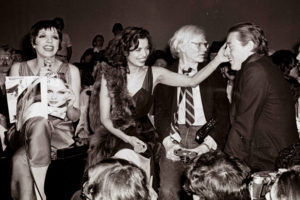
Party Like it’s 1977
Infamous by name, New York’s Studio 54, served as a glitzy yet, dingy playground for the rich and famous nightclub crowd. Why was it such an enigma? Why did it catapult to the top disco in the world at rocket speed? Why did it come crashing down? Why did it only last 33 months? Who were the owners and who were the players? All of these questions are answered in director Matt Tyrnauer’s excellent documentary “Studio 54” and more.
If you were looking to rub elbows with the rich and famous during the 70s while dancing the night away, you’d head for the Tenderloin neighborhood that bordered the theatre district, where you couldn’t miss the long lines of limos waiting in the streets, along with the popping flash-bulbs of the paparazzi and hordes of frantic hopefuls all appealing to be granted access to step into the club. Here, the velvet rope served as a “keep out” gate, nope, one could not even pay to get in—you had to look the part and be chosen by either a doorman or one of the owners, Steve Rubell, himself. Such a strategy created the hottest place in town.
What made Studio 54 so appealing according to the documentary is the idea of providing a haven for personal expression. Once people stepped inside, a sense of “freedom” and inhibition flooded over them—freedom, to be themselves, whether gay, bi, or transgender, while also breaking down barriers of race, celebrity and status. Michael Jackson, Truman Capote, Mick and Bianca Jagger, Liza Minnelli, Halston, Diana Ross, Mikhail Baryshnikov and Cher were seen there often, as well as many other celebrities. The building was set in the old CBS-TV studio that was home to big-time shows such as What’s My Line? and The Jack Benny Show, the building was already a space with a theatrical history. In the darkened balcony above, patrons indulged in sexual rendezvous’ while down below, in the rusty piped, grimy basement—drugs could be scored, along with sex upon random mattresses.
Through the partnership of two highly ambitious young owners from Brooklyn—Ian Schrager, a reputable lawyer and married heterosexual, and his publicity-addicted best friend from college, a gay extrovert named Steve Rubell—Studio 54 was a home run. As shown through rare archival footage, Manhattan’s nightlife has a dark past, the candid narration by Schrager himself explains why everyone wanted to get in. Opening on April 26, 1977, at the height of the disco craze, Schrager was the intellect behind the scenes—he made the business deals and signed the contracts—Rubell managed the PR laying the groundwork to lure in patrons. Together, they were a dynamic duo. The opening occurred without a liquor license, which was one of the reasons for their eventual downfall, although not the entire story.
If you got in Studio 54, it was front-page news. The velvet ropes went up on 54th Street, with doormen clutching guest lists in hand from everyone from Liz Smith to Reggie Jackson. The rules changed nightly as how to get in, but it was a given that you couldn’t get in wearing a baseball cap, a beard, or anything polyester. Admittance was merely subjective, often depending on your attractiveness, funky outfit, or the personal whims of Rubell.
Studio 54 came to a crashing halt with both the onslaught of AIDS and a police raid at 9:00 a.m. on Dec. 14, 1978. Charged with numerous counts of extortion and the uncovering of narcotics, a skimming operation that cheated the IRS out of an unreported $25 million could not be ignored. Schrager and Rubell were arrested and indicted on 12 criminal counts of tax evasion; we view the aftermath of these two in jail. The New York magazine cover said it all: “Studio 54—The Party’s Over!”
The Bottom-line: A highly remarkable documentary as Schrager’s candid and at times squirmy narrative provides an authentic, ‘Here’s what happened picture.’
Sarah Knight Adamson© October 17, 2018
